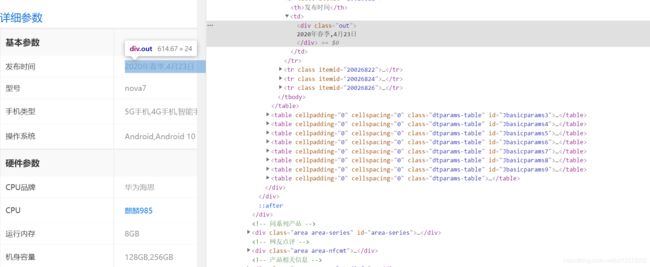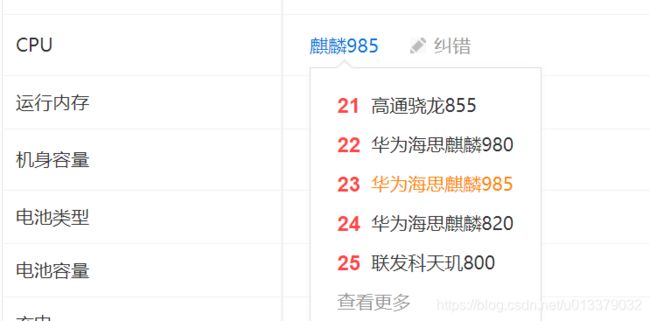【爬虫】获取手机详细参数爬虫脚本详细解析
起始初衷
朋友工作需要手机的性能详细列表,本来以为网络上应该已经有很多相关的文件可以直接下载了,但是依旧没有找到比较满意的。这时候正好被推荐了PCOnline上的手机详细参数,突发奇想闲着没事用Python写了一个整理手机详细信息的脚本。
工具
1. python 语言和解释器
2. python 的requests,BeautifulSoup4,xlwt(因为朋友希望整合成excel, 也可以替换成pandas,毕竟xlwt无法保存成xlsx)
编码干活
1. 获取目标网址
https://product.pconline.com.cn/mobile/ , 通过点击第二页 https://product.pconline.com.cn/mobile/25s1.shtml 以及第三页 https://product.pconline.com.cn/mobile/50s1.shtml
很容易可以知道页数和连接的关系为
“https://product.pconline.com.cn/mobile/“ + 25 * i + "s1.shtml"
2. 大家都会写的request,这边就不多解释直接上代码了
def request_html(url):
headers = {'User-Agent': 'Mozilla/5.0 ' \
'(Macintosh; U; Intel Mac OS X 10_6_8; en-us) AppleWebKit/534.50 ' \
'(KHTML, like Gecko) Version/5.1 Safari/534.50'}
response = requests.get(url, headers=headers)
response.encoding = "utf-8"
return response3. 获取每个Item的链接。
利用chrome或者firefox的检查(inspect)工具,可以了解到每项产品的链接和图片链接。
点击到产品详情页,举个例子,https://product.pconline.com.cn/mobile/huawei/1268787_detail.html页面,这个详细页面解释上面的产品连接加上 "_detail"的标签。
于是我们可以对之前的response进行解析。获取每个
def parse_items(text):
global link_list
soup = BeautifulSoup(text, 'lxml') # 声明BeautifulSoup对象
item_list = soup.find_all('li', attrs={"class": "item"})
for item in item_list:
link = item.find('a', attrs={"target": "_blank"})
if link is not None:
url = link.attrs['href']
link_list.append(url)(这里存在一个问题,如果我们通过应该能够获取到图片的连接地址,不过在实际操作过程中,获取到的地址是一个blank.gif, 说明这个地址是被替换过了。对于该问题这里倒没有想办法处理,而是另辟蹊径,后续会讲解。)
4. 获取每个设备的详细参数
进入到detail页面,同样通过检查工具获取相应的html源码
和步骤3的流程一样,解析一下Html,获取里面的text,先上代码再做解释
def collect_param():
global link_list
global device_list
for link in link_list:
url = "https://" + link[2:-5] + "_detail.html"
response = request_html(url)
param = BeautifulSoup(response.content, "lxml").find_all("tbody")
total = {}
for item in param:
if item != '\n':
for tr in item.find_all("tr"):
if tr.find("th") is not None:
try:
key = tr.find("th").text
val = tr.find("td").text.strip()
if '•' in val:
val = val.split('•')[0]
if key == 'CPU' and tr.find("td").find('a', attrs={"class": "poptxt"}) is not None:
val = tr.find("td").find('a', attrs={"class": "poptxt"}).text.strip()
if key == '型号':
img_url = parse_img_url("https:" + link)
download_img(img_url, val)
total[key] = val
except AttributeError as e:
print(tr)
device_list.append(total)
# print(total)代码中有几个点需要解析一下,就是在文本页面中存在一些超链接和标签问题需要过滤。针对上面代码中的几处 “if” 进行解释下
(1)在获取操作系统或者手机类型的时候,页面会弹出如下的Tab。
这里为了偷懒,不对详细的内容进行解析,但是从获取到的文本中可以看到在显示这些内容的时候都会带有 '•'符号,因此直接过滤就行了。
(2) 在获取CPU数据的时候会出现排行表,同样需要进行过滤,但是这边的排位比较随机,虽然也可以通过正则表达式进行过滤,感觉还是比较麻烦,所以还是处理了一下。
(3) 当获取到手机型号的时候,由于之前所要求的要下载手机图片,所以这里以手机型号为名称保存图片。先上代码:
def parse_img_url(url):
response = request_html(url)
div = BeautifulSoup(response.content, "lxml").find("div", attrs={"class": "big-pic"})
img_url = div.find("img").get("src")
return "https:" + img_url
def download_img(url, name):
headers = {'User-Agent': 'Mozilla/5.0 ' \
'(Macintosh; U; Intel Mac OS X 10_6_8; en-us) AppleWebKit/534.50 ' \
'(KHTML, like Gecko) Version/5.1 Safari/534.50'}
r = requests.get(url, headers=headers, stream=True)
# print(r.status_code) # 返回状态码
if r.status_code == 200:
open('img/' + name + ".png", 'wb').write(r.content) # 将内容写入图片
# print("done")
del r之前说到了,图片的src地址获取到的是一个"blank.gif",这里不做深入研究,直接另辟蹊径,下载的是item概览的那张图片,并且以手机型号作为名称保存在本地的img文件夹里,对路径的解析同之前一样。
5. 整合成excel表格
没有太多的解释,直接上代码把。
def write_excel():
workbook = xlwt.Workbook(encoding='utf-8')
worksheet = workbook.add_sheet('phonesheet')
title = list(device_list[0])
for i in range(len(title)):
worksheet.write(0, i, title[i])
for i in range(len(device_list)):
for j in range(len(title)):
if title[j] not in device_list[i]:
worksheet.write(i+1, j, "None")
else:
worksheet.write(i+1, j, device_list[i][title[j]])
workbook.save("phone.xls")第一行写入所有的参数名称,也就是Key,后面逐行写入参数值,最后保存成文件。这边不太需要解释。
6. 总结
这里得感谢网站没有做太多的反爬虫设置把,大多数的过程都比较简单。保存一下当一次经验谈。因为是比较清晰简单的脚本因此也没必要上源码了。如果想要运行的话把上面的所有函数复制下来,然后加上如下的main函数就行了。
if __name__ == "__main__":
data = request_html('https://product.pconline.com.cn/mobile/')
parse_items(data.content)
collect_param()
print(len(device_list))
with open("phone.json", "w", encoding='utf-8') as f:
f.write(str(device_list))
write_excel()




